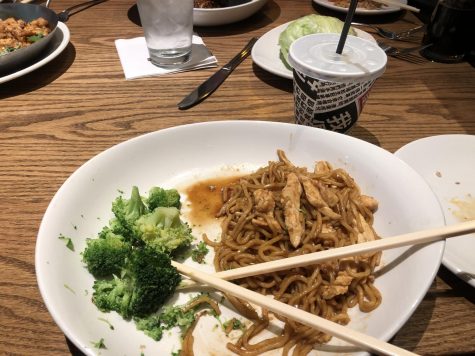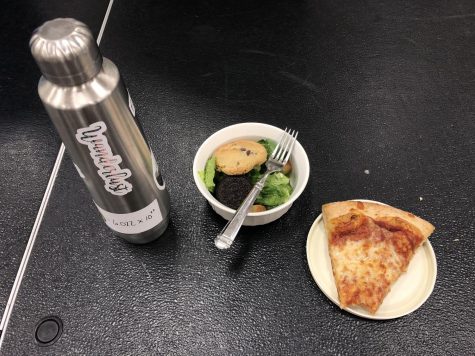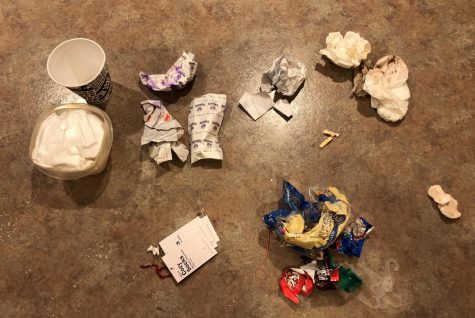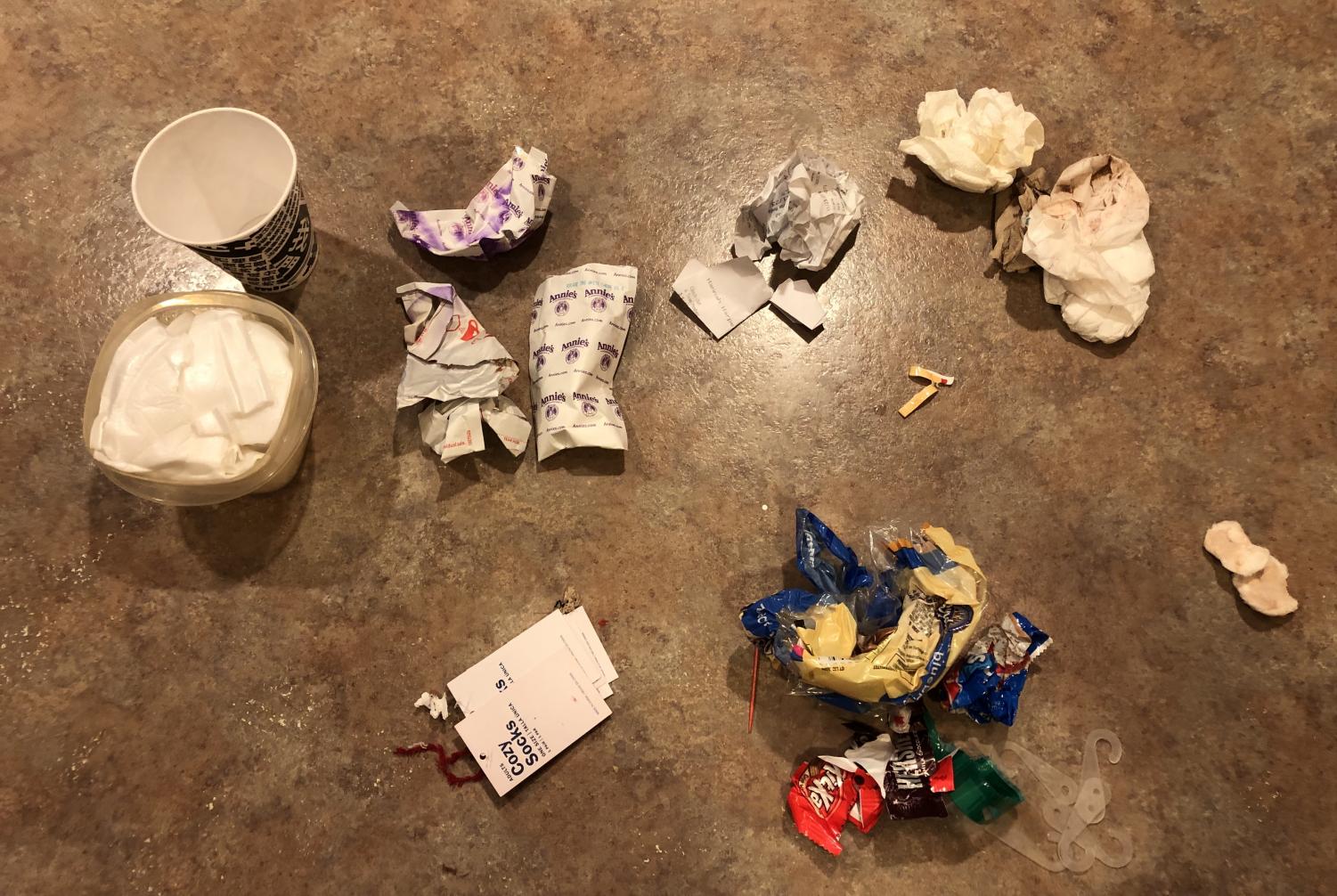Three Weeks – No Trash – Planet Saved?
A day to day odyssey on eliminating waste production
December 17, 2018
Trash. Billions of tons of trash end up in landfills every year, piles of plastic, food waste, and paper waste lay in dumps to rot down over the next hundreds of years. With all of this trash in landfills, it is surprising to learn that over 80 percent of trash in landfills is recyclable. Landfills are the number one soil polluter in the United States, and from all of the trash in the ocean, eighty percent was originally placed in landfills.
I have been passionate about the environment for a long time, but this step I am trying to take is different even for me. I realized earlier this school year that consumption of unsustainable goods around the globe is what is truly contributing to the lack of respect we have for the planet and for future generations.
So I’ve decided to do something about it. This year, I have been making it a priority to reduce my waste and create a more sustainable life for myself, and try to help my family along the way as well. But for the next three weeks, I’ve decided to take it to the next level; zero waste lifestyle. I will be trying to live my life as normally as possible, but creating no waste along the way. Any small things I do happen to have to throw away, things that are small enough or necessary items, I will be putting in a mason jar. That means I will be recycling everything I can, as well as starting a compost bin sometime within this time frame.
So here’s to the challenge. 21 days, here I come.
Day One
So after today, I’ve realized this might be a little harder than I thought. LIke always, I packed my lunch in reusable, glass containers, and had my iced coffee in my reusable cup with my metal straw. But then, after washing my hands in school, I instinctively grabbed a piece of paper towel to dry my hands off.

One thing I’ve thought about during this challenge is the fact that there is a lot of trash produced in production lines that create the food, clothing, and other objects in our everyday lives. This trash is never seen by the consumer, and that will not be considered a lot of the times when people go “zero-waste” or live a “zero-waste” lifestyle. In the background of the production of our food in restaurants, factories, or in other countries where textiles and plastics are produced or manufactured, there is waste that will never be considered as part of our individual waste because we do not see it.
This waste is expanding the externalized costs we have on other countries. As Environmental Science teacher Jim Walker explains, here in America we have it a lot better than countries with less regulation regarding landfills.
“In developing nations, it’s cheaper to throw stuff away, and they’re throwing it all in a big pit, and then that stuff’s leaching out as rainwater goes through there and dissolves a lot of stuff and mixes it together,” said Walker. “This is going to create future health problems for them, and they’re going to be paying [with their health] for the cheap costs of their manufacturing and mining ten, twenty, even thirty years down the road.”
Not only this, but many of our trash produced by us isn’t even in our daily lives, but in the manufacturing of the goods we use in these poor countries. The trash we use and produce every day doesn’t even compare to the amount of garbage made in the poorer countries where our good are produced cheap, and the health and environmental effects of our throw away lifestyle are seen even halfway across the world.
Pro environmentalist tip: Turn off the faucet water when brushing your teeth, and although this may be overstated, but according to North Carolina State University, you could save up to 2,400 gallons of water per year by just turning off that tap.
Day Two
Today was semi-formal, and things went much better than planned. My tags from my dress went into the mason jar, sadly, but during dinner, I asked for no straw, and let someone else use my napkin since they needed it, lessening the waste created if she had had to ask the server for another napkin. At the dance itself, there were water bottles and small mints, but instead I went out and drank from the water fountain, and took home my one water bottle I used and recycled it. I would have taken my own reusable water bottle into the dance, but figured that wouldn’t be the smartest idea. Overall, today wasn’t really any different from another person’s semi-formal day, the only exception being that I didn’t put anything in a landfill.
In conjunction with using plastic water bottles at a school dance, there are millions of plastic, single-use water bottles used every day across the globe. Every day in school, there are kids who buy water bottles from the lunch line, bring them from home, or buy them from the vending machines. This is such a problem because water is such a wasted resource. It is a resource around the globe that we take for granted every day. In our own state there are factories producing these water bottles, especially by the great lakes. The production of these water bottles is very unsustainable, whether they are taking water from the great lakes or from wells underground.
For example, there is an extremely large underground water reservoir in the western states called the Ogallala Aquifer. It is the largest aquifer in the United States, and because of this fact, it have been taken advantage of. Over the years, water bottle companies and towns around and above the aquifer have over drained the aquifer and its size has shrunk drastically. Because it is under states like South Dakota, Nebraska, Kansas, and even the top of Texas (major farming states), the farmers have become extremely dependent on this water source. Ninety percent of the water used from this aquifer is used for farming, and if completely drained, it would take six thousand years to refill naturally, according to Scientific American. Water waste is a large problem, as well as taking advantage of single-use water bottles.
We as Americans can conserve large amounts of plastic by buying stainless steel water bottles. I have a stainless steel water bottle I take everywhere, and it keeps things cold or warm for over twelve hours. Not only are reusable water bottles a great investment to your bank account, but it can also be a great investment in our futures on this planet.
Pro environmentalist tip: Take a reusable water bottle everywhere. What I have found is that if I take my 24-ounce reusable water bottle to fast food chains, they will most likely just have you pay for that size of drink and will allow you to use your own water bottle. Its super easy and can save hundreds of single use cups from reaching the landfill
Day Three
Today was one of those days where I made a change that does affect my life a little more. I worked a nine and a half hour shift, and according to the law, you have to have at least a thirty minute break every six hours. So that meant that I would not be able to do what i normally do at work and just purchase food, because then i would have a very large amount of things to throw away.
So today I packed my lunch for work. Yes, it was a little awkward sitting in the dining room of my employer, eating a bagel and yogurt in my work uniform, getting strange looks from the customers around me. But, it was worth it since I not only saved about five dollars, but I was also able to get through the day without having to add anything to my trash jar.
The costs and environmental impacts of trash and landfills not only have to do with the landfills, but have to do with the process of trash collection and overall consumption.
“Getting the garbage to the landfill itself is going to take energy, to move all that around. You’re going to have garbage trucks filled up with diesel fuel,” said Walker. “Not only this, but after the trash is dumped in landfills, there are large amounts of methane that need to be collected and leachate needs to be collected as well to keep groundwater from being contaminated.”
Our current society had become okay with throwing everything away. It takes time away from things we deem more important than saving a piece of plastic from going in the landfill, and this mentality is what is ruining our society.
“By throwing away and buying new all the time, it creates a high throughput economy, and the demand for raw materials and manufacturing is very high, so globally, the cost of manufacturing and mining in third world countries is all externalized costs, onto the environment, people’s health, and the future,” said Walker. “The multinational corporations have found ways to access very cheap raw materials and labor because we have surging populations in these countries, and that pushes the high consumption lifestyle because we get things so cheap. So why would we spend time to clean it, repair it, even if it is now cheaper to buy raw materials from third world countries.”
Pro environmentalist tip: Stop reaching for a plastic straw at home! Try switching to metal straws. Packs of four straws, with a straw cleaning brush and earth friendly travel case start at five dollars! Not only good for the environment, but will save you money in the long run, not having to buy plastic straws ever again.
Days Four- Seven
I had a minor slip up this past Saturday. I went out to eat and forgot to take a Mason jar to place my leftover food in so I could reheat them and eat them the next day. I had to decide between wasting my food (which cost me money) or a styrofoam container. It was a difficult choice, because styrofoam is extremely bad for the environment. It is composed of small particles of plastic, so when it breaks down in landfills, it can be carried away by rain and the small particles end up in water sources, where fish and other living things can get them into their system, where they won’t be able to digest it. This fact slipped my mind, even though I knew how bad it was for the environment, I used it for my food. I have put the styrofoam by the mason jar of trash, which is still not very full.
These past few days have been pretty normal, going to school, eating my packed lunch out of reusable containers, practicing for the musical.
One thing that is new is that I have decided to start a compost bin in my household, where we will put food scraps that cannot mold or spoil, such as coffee grounds, banana peels, and other fruit and vegetable scraps. These things will go into the raised garden beds behind my house, which will act as a natural fertilizer throughout the winter so that by the time we plant things in the spring, our soil will be ready to support life.
The biggest reason for creating a compost bin is that it will keep food scraps out of the landfill. Many people may be confused to as why food scraps in landfills is a bad thing, because food breaks down and creates a substance that is not harmful to the soil or the environment around the dump. The problem with food scraps in landfills is that because the decomposition of the food causes buildup of gases when it is confined to a plastic bag or piled under pound or tons of trash. This build up of gas is very dangerous and it the reason there are pipes that can be seen from the tops of landfills, to let out the methane from the trash pile. It’s a big problem, and composting helps with this because instead of a buildup of gases, these decomposing foods can release these organic compounds as fertilizer instead of methane.
Pro Environmentalist Tip: Recycle everything possible. Many things that you use in everyday life are recyclable, you just never notice. Take the time to look underneath your one-use plastic containers you get at restaurants, or take water bottles home from a party that doesn’t have recycling. It is easier to recycle, and keeps plastic and metal out of the landfills, where it takes hundreds of years to decompose.
Days Eight- Twelve

These days were during the school musical, a time where we go out to eat after every show. The first two nights, we went out to different restaurants, where it wasn’t that hard to avoid making trash. Though I had to use napkins, I took those home and put them in my recycling, where they could be repurposed for other things, since the napkins were recyclable. I asked for no straw, which isn’t very hard to do to avoid making trash. Along the lines of the musical, there is not much trash to be made. All of the wood used in the show props and set are reused for many things. All of the stage set that is moved on is used in multiple shows, and the costumes are selected from the costume room or from your own closet. The sustainability that the program has is what allows it to continue to perform the shows without having to buy brand new sets every year.
In terms of considering sustainability in everyday life, we have to remember to be conscious about our decisions. In order to live a sustainable lifestyle, I’ve made the choice to not eat beef. It has been a few months since I made this conscious decision. It started last school year, because I took AP Environmental Science and we had a week long challenge to not eat beef. The reason being that beef is detrimental to the environment. It takes up ten times the land that chicken does, and it takes about seven gallons of water to make one pound of beef. When thinking about sustainability, beef does not come into the equation. Third world countries are deforesting their entire environment to have cattle fields to sell beef. This deforestation is devastating, and the effects of this deforestation can be felt worldwide.
Pro Environmentalist Tip: Buy cloth napkins to reduce the waste of everyday meals. According to alexrubbish.com, Americans throw over 2,200 napkins away every year, totaling about six napkins a day, and if every American threw away one less napkin a day, a billion pounds of napkins would be saved from landfills. So by using reusable napkins, thousands of pounds of trash could be saved from your everyday life.
Days Thirteen- Seventeen
Ahh, Thanksgiving break. A time to gather with family, eat until you can’t move, and take endless food coma naps after dinner. But what many people don’t realize is how much waste is created by holiday season. Many Americans during the holidays anticipate that they can eat more than they are actually able to, so they load up their plates so full that they might need to add a second. Although many Americans eat lots of turkey during Thanksgiving day, about 200 million pounds of turkey meat are thrown into the garbage after your meal, according to marketwatch.com. So much food waste is created during the holidays, which seems a little strange since many Americans don’t have enough money to have a Thanksgiving day meal, or any meal at all. Not only this, but since many families are so focused on making food, they don’t want to have to waste time cleaning dishes after their family members eat, so plastic silverware, plates, and cups are used. While many of these products are recyclable, many of them still end up in landfills because it’s not very common to have to think about during the holiday season.
At my family Thanksgiving, we used glass plates, reusable silverware, and plastic cups that were all recycled at the end of the day. Our food was all eaten, since it was a fairly small amount of people, and whatever wasn’t eaten was placed in containers to be eaten later in the week. It is these small changes in habit that can really affect how much garbage goes from your house to the landfill throughout the holiday season.
Take for example, Christmastime. This holiday season, take the time to appreciate the family and friends you have around you instead of enjoying the presents. The consumption of goods during birthdays, Christmas, or other holidays is a large portion of trash that you receive with no intent of ever using.
“When people have conversations, or people have real, meaningful experiences with one another, those experiences are worth way more than the short term, materialistic gratification you get when your unwrap a book that somebody bought you for Christmas,” said Walker.
Pro- Environmentalist tip: Don’t throw away your leftovers! If it is food that can be placed in the refrigerated and reheated within the next week to enjoy, then place it in a container instead of in the garbage bin. Food scraps that end up in landfills, piled under plastic, can create trapped methane when decomposing, a harmful gas even worse than CO2 for the atmosphere. Any leftover scraps that are fruits or vegetables can be placed in a compost bin, that can be taken to a bio waste facility in any city, and can be made into soil and fertilizer for farms. Any meat leftovers can be used for sandwiches or soups, instead of going into the garbage to mold.
Days Seventeen- Twenty-one
These last few days have been full of consideration about my effects on others with trash. I’ve been thinking about the end of this “challenge” and what these last few weeks have done, and really thinking about the point of doing this project. In order to make a lasting effect on the world, we can’t just do these types of challenges and then go back to everyday life, throwing everything away without any consideration about it’s negative effects on other people. In order to really make a difference I need to implement some of the things I’ve been doing over the past three weeks to really change my mindset and lifestyle. Not buying school lunch, recycling everything possible, and rethinking choices I make that may produce trash are just some of the many things that I will be keeping in my life from these three weeks.

Recent historical improvements in society are the reason that many people live this grab and go, throw away lifestyle. It has become easier and easier to throw away a water bottle without even a second thought about where the cost of plastic in the environment will be passed onto. In the 1950’s, consumerism reached it’s epiphany of marketing; cheap, non reusable goods that would keep consumers consuming and demand high for cheaper products
“So in the 50’s consumerism was a really big deal… we wanted people to buy more stuff, because the more we bought, the more demand there was for products, so more jobs could be created or the more sales could be carried out, which meant greater profits for the manufacturers,” says Walker. “If we had a system based more on thrift and reuse, extending the products life cycle, there wouldn’t be as much consumption, so ecological footprints would go way down, but then sales of products would go way down as well.”
When thinking about trash, garbage, junk, it is easy to pass blame onto others. Saying “Oh, well if I don’t buy it someone else will, so it’s going in the trash anyway,” is so easy to day and believe, but this is the mindset that is ruining our world. All of this waste, all of this negativity is passed onto countries that cannot afford anything, countries that will willingly take our trash because our privileged countries will pay them to let us dump our waste on their land. There is no positives when it comes to trash production. Within the next few decades, we will be hitting our oil max, and the gas, plastic, and oil prices will go up because of our unsustainable use of these nonrenewable resources. It is unfair for us, the human population, to take and take and take, but we never stop to consider the fact that everything we take from ourselves now, will affect every single one of us in the future.
In a Ted Talk about climate change, Al Gore talks about how much we affect the environment around us, how positive change will be coming, needs to be coming, in the future. But he also says this; “How dare we be optimistic”? In order to truly spark change in our world, we cannot be positive and happy with our progress towards change until we no longer have a hole in the ozone layer, ice caps are growing instead of melting, plastic is all recycled with glass and metal, and species are no longer dying off. We cannot afford to be optimistic right now, because the times we are living in are not optimistic. People are only taking a small chunk of their day to make a difference, but are not voting on legislation that can positively affect the world, because they think it’s “fake”. People that deny this change are avoiding the inevitable. It’s not fair to the planet, and it’s not fair for ourselves.
Pro-Environmentalist tip: Take the time to consider your own effects on the world. Are you making a positive difference or a negative difference. Think about your choices in life, and consider any small, tiny, seemingly insignificant changes you could take in your life and make those changes. What seems small in the long run can make a huge difference for our future.
